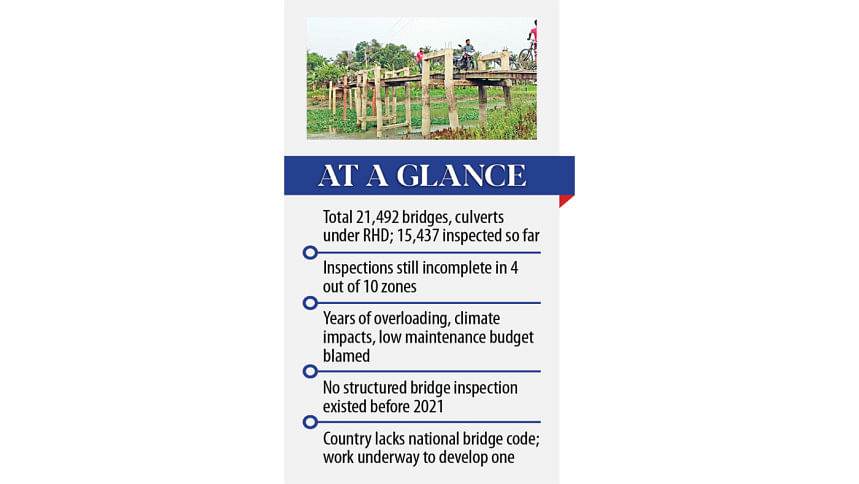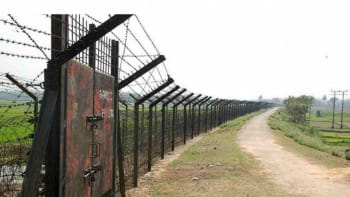Over 700 bridges, culverts ‘highly risky’

More than 700 bridges and culverts under the Roads and Highways Department (RHD) have been found to be highly risky and in need of urgent repairs, according to an RHD survey.
The actual number may be higher, as inspections are yet to be completed in four out of 10 RHD zones.
The findings were revealed at a discussion titled "Bangladesh Bridges: A Roadmap for Safety, Sustainability and Hazard Mitigation", held yesterday.
The event was organised under the SASEC Road Connectivity Project-2 in collaboration with the Buet-Japan Institute of Disaster Prevention and Urban Safety (BuetJIDPUS) at Buet's Council Bhaban.
In a presentation, Shishir Kanti Routh, additional chief engineer (bridge management wing) of RHD, said there are 21,492 structures -- 7,741 bridges and 13,751 culverts -- under the RHD network.
RHD began its first periodic inspection of these structures in December 2021. So far, 15,437 structures -- 3,113 bridges and 12,324 culverts -- across six zones have been inspected.
Inspections in Rangpur and Cumilla zones were completed between 2021 and 2022, while Chattogram, Sylhet, Khulna, and Barishal zones were covered later.
Of the inspected structures, 13,406 (86.8%) were rated A-category (in good condition), 1,277 (8.3%) B-category (minor issues), 42 (0.3%) C-category (some risk), and 712 (4.6%) D-category (highly risky and in need of immediate repair).
When this correspondent asked Shishir Kanti about the reason behind the large number of D-category bridges, he explained that until 2021, RHD had no structured bridge inspection practice, and this first comprehensive inspection revealed the extent of the problem.
He said years of overloading; climate change impacts like rising temperatures, humidity, and salinity; and inadequate maintenance budgets have contributed to the poor condition of many structures.
Regarding current efforts, he said maintenance work is underway based on a priority list.
However, delays are being caused by challenges such as drawing designs for a large number of bridges, funding shortages, and the limited capacity of local construction firms.
He also said Bangladesh still lacks its own bridge construction code and currently relies on foreign codes. "We have now taken steps to develop a national bridge code," he added.
At the event, Sheikh Moinuddin, special assistant to the chief adviser for the Road Transport and Bridges Ministry, said although engineers use the AASHTO (American Association of State Highway and Transportation Officials) code, it should be adapted to local conditions, including climate factors.
He stressed the need for better collaboration between departments and between professionals and academia, breaking the existing siloed approach. He also encouraged drawing on the experience of Bangladeshi experts living abroad.
Prof Nur Yazdani, director of the Next-Gen Sustainable and Resilient Infrastructure Lab at the University of Texas, said bridge inspections should be more structured.
He also said Bangladesh should develop its own load model based on local vehicle types.
BUET Vice-Chancellor Prof ABM Badruzzaman called for greater collaboration between local and expatriate experts.
Prof Shamsul Hoque of Buet's Civil Engineering Department said structural reforms are necessary and political leadership must take initiative in this regard.
He stressed that proper planning is more important than just monitoring, and suggested the metro rail authority conduct a technical review of the first metro rail project to avoid flaws in future ones.
RHD Chief Engineer Syed Moinul Hasan; Bangladesh Bridge Authority Chief Engineer Quazi Muhammad Ferdous; and Prof Tanvir Manzur, director of BuetJIDPUS; also spoke at the event.
SASEC Road Connectivity Project-2 Director Waliur Rahman chaired the programme.

 For all latest news, follow The Daily Star's Google News channel.
For all latest news, follow The Daily Star's Google News channel. 



Comments